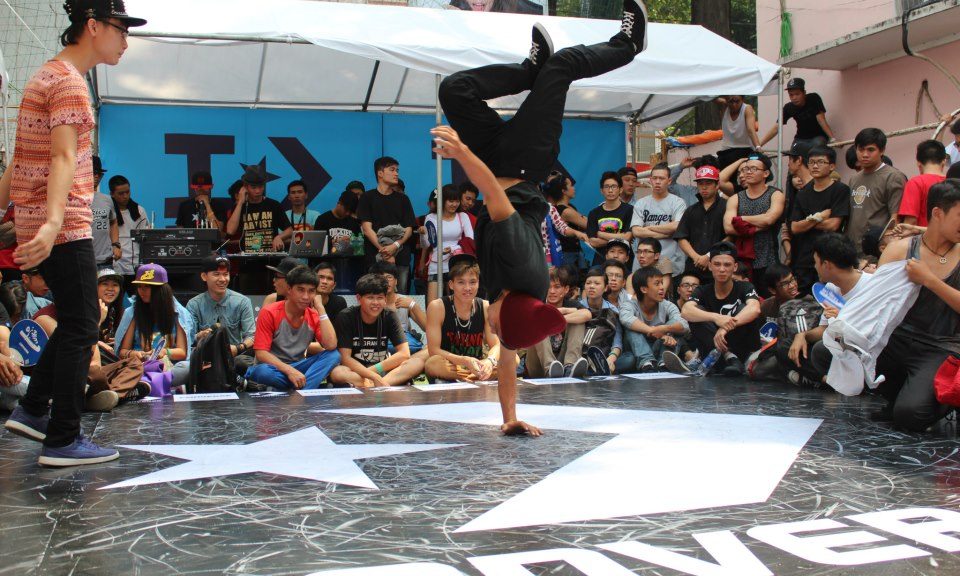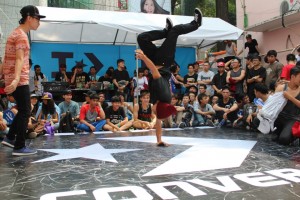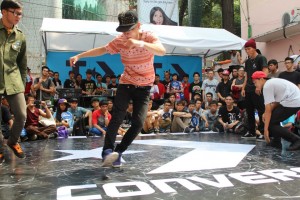
Through the Lens of Hip-Hop: Vietnamese Youth Culture

Converse shoes, beanie caps, graffiti, and break-dancing are all elements of today’s hip-hop scene in Vietnam. While these facets aesthetically resemble a similar culture in the United States and other parts of the world, Vietnamese hip-hop conveys a deeper message hidden under the clout of imported flash. MCs, graffiti artists, b-boys, and DJs comprise only one of the counter-cultures that have developed in Vietnam through the processes of globalization. As one of the most youthful countries in the world, Vietnam must balance the traditional customs of past generations with the trends and developments of today’s world.
I have chosen this picture to expand upon for a number of reasons. Having been involved in the hip-hop scene in the U.S., I hope that I can relate to similar minded youth in Vietnam. I believe that Vietnamese hip-hop is a developing culture that is different than similar subcultures in other countries. Finally, I view the hip-hop subculture in Vietnam as lens through which one can visualize Vietnam’s progress and development.
In the early 1970’s hip-hop formed in the Bronx in New York City as a form of self-expression and protest by the youth. As it spread, the messages associated with the movement also found audiences in Europe, Asia, and other parts of the world. By the end of the 20th century, and with the economic success of the early 21st century, Vietnamese youth readily gained access to the rest of the world through venues such as MTV, the internet, and their neighbors in Asia. It wasn’t long after that a hip-hop culture developed in Vietnam.
However, in my observation and interaction with hip-hop artists in Vietnam, there is an almost entirely different message being portrayed underneath all the baggy shirts, flat brim caps, and break-beats. While American hip-hop music is notorious for off color language and a subculture that often lends itself an unsavory reputation, Vietnamese describe their brand of hip-hop as “clean.” Raps are often about romance, youth culture, dancing, expressing yourself, and being who you want to be. There are almost never political or societal issues conveyed through Vietnamese hip-hop. The overall message is resoundingly individual and being true to yourself.
As said in Saigon Electric / Yo!, a 2011 film exploring Vietnam’s street dancing scene, “We [Vietnamese] dance because we have to. It’s all we have to live for.” I believe that this quote highlights the ambiguity of the task Vietnamese youth have in forging their own culture. When President Clinton visited Vietnam for the first time in 20 years following the end of the conflict in Vietnam, he was exposed to a new generation of Vietnamese who had the freedom to find futures beyond the wars of their parents and grandparents’ generations. However, as Vietnam steadily opened up to the rest of the world, the next generation of youth have pushed the envelope even further in the creation of a unique, and thriving youth culture.
Converse’ arrival and success in Vietnam display just how eager Vietnamese youth are to ‘catch up’ with their contemporaries around the world. While Converse’s image might inspire images of old-school basketball or pop-punk bands and skater culture in the United State, Converse has harnessed a slightly different approach in Vietnam. The Converse Street Festival in Ho Chi Minh City represents nearly a decade of growing presence in Vietnam. While staple “Converse cultures” such as skate boarders, rock bands, and b-boys transitioned and took root in Vietnam, Converse successfully marketed itself to a population that literally grew up with the brand in Vietnam. While it seems that Vietnamese artists in the hip-hop scene earnestly take their inspiration from the United States, Europe, South Korea, Japan, and other hip-hop centers, a unique Vietnamese identity is slowly taking shape.
When I arrived on site at the Converse Street Festival, there was already a large crowd gathered on the main stage where the b-boy crews were battling. I noted that with few exceptions, nearly everyone in the crowd was my age or younger, and that their energy far exceeded what should have been possible for the amount of people. I have been to jams (b-boy competitions) many times larger in Chicago and the United State, but the excitement and talent of the performers, spectators, and judges in Vietnam was just as comparable!
Hip-hop in Vietnam, through conveyed through the same vehicles as ‘original hip-hop’ across the world, conveys a deeper story. The growth of this subculture parallels the development of Vietnam in recent years, not only economically or culturally, but also consciously. I believe that it would not be too farfetched of a statement to say that Vietnamese hip-hop is proof of Vietnamese identity taking new shape in an uncertain future. With over half of its population under the age of 30, Vietnam’s youth are eager to soak up the rest of the world’s trends. However, they do not seek to just catch up, but also gain the tools to forge their own of unique identity whether it be through industry, policy, or something as obscure as street dancing.
Roadside Tagging in Mui Ne
A B-boy starts his routine
A semi-related preview of my holiday break in Nha Trang
For more info on the Vietnamese Hip-Hop scene, specifically b-boying check out these links!


